What is loyalty? Nine drivers and four major benefits of Loyalty
Loyalty, in the context of using the same brand of payment method in an e-commerce environment, refers to the customer's willingness and preference to consistently utilize a particular payment brand or method when making online transactions. It implies that the customer repeatedly chooses the same payment brand or method over alternative options available to them.

The concept of loyalty in this context typically involves the following four aspects:
-
Brand Preference:
Loyalty involves customers actively selecting and favoring a specific payment brand or method when making purchases online. They might do so due to factors such as trust, convenience, familiarity, positive past experiences, or perceived benefits associated with that particular payment option. -
Repeat Usage:
Loyalty is demonstrated by customers consistently using the same payment brand or method for their online transactions over time. This implies a level of trust and satisfaction with the chosen payment option and a reluctance to switch to alternatives. -
Resistance to Change:
Loyal customers exhibit a resistance to switching to other payment options or brands, even when presented with various alternatives. They may stick to their preferred payment method regardless of temporary promotions, discounts, or incentives offered by competitors. -
Advocacy:
Loyal customers may become advocates for the preferred payment brand or method, promoting it to others through positive word-of-mouth or online reviews. They may share their positive experiences, recommend it to friends and family, or defend their choice against criticism.
Overall, loyalty in the context of using the same brand of payment method in e-commerce signifies a customer's consistent and preferential utilization of a specific payment option due to factors like trust, convenience, positive experiences, and a reluctance to switch to alternatives.
Dutch consumers tend to exhibit a certain level of loyalty to online retailers such as Picnic, Bol.com, Zalando, Just Eat (Thuisbezorgd), and Amazon.nl. These companies have established a strong presence in the Dutch e-commerce market and have gained a reputation for providing good customer service and a wide range of products.
In Germany, on the other hand, there are several online retailers that have gained significant popularity and loyalty among online shoppers. Some of the well-known e-commerce platforms in Germany include Zooplus, Booking.com, Amazon.de, Zalando, Otto, Just Eat (Lieferando), and eBay.de.
Who is the most Loyal?
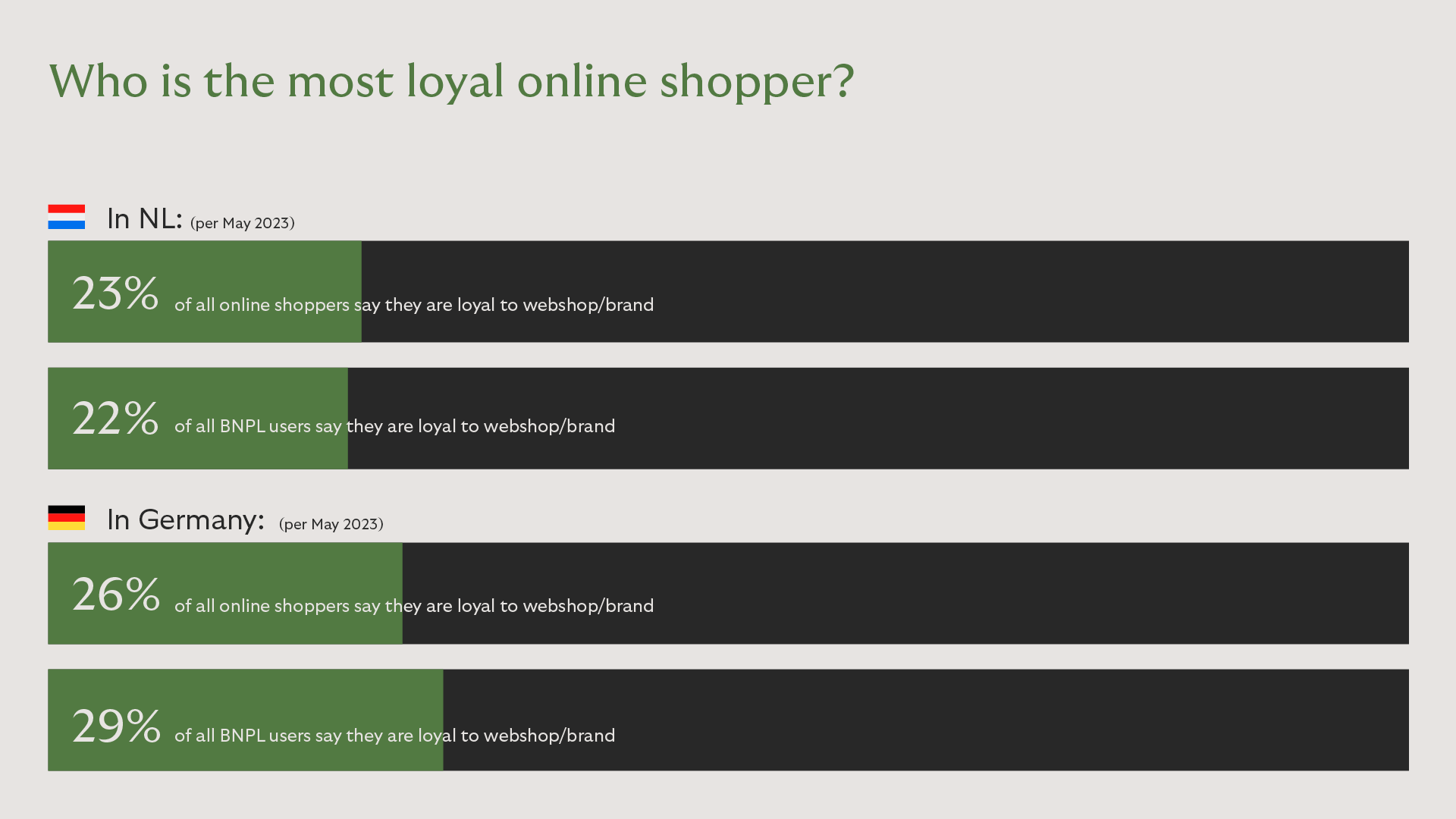
In the Netherlands:
23% of all online shoppers say they are loyal to webshop/brand
22% of all BNPL users say they are loyal to webshop/brand
In Germany:
26% of all online shoppers say they are loyal to webshop/brand and 29% of all BNPL users say they are loyal to webshop/brand
Loyalty does not make a difference whether you are a High, Medium or Light shopper. All shoppers, identify as male or female, living in Germany or the Netherlands. All these demographics lie around 27%, which is the highest.
What drives loyalty: 3 x 3 things a brand or webshop needs for shoppers to become loyal.
Several factors contribute to online shopper loyalty to a specific brand or webshop, which can be devided into three different blocks:
1 = factors to draw shoppers to your webshop
2 = factors to drive purchases
3 = factors to make shoppers return to your webshop.
Loyalty key factors:
Factors to draw shoppers to your webshop:
- Exceptional Customer Experience
- Product Quality and Variety
- Competitive Pricing and Discounts
Factors to drive purchases:
- Trust and Credibility
- Social Proof and Reviews
- Exclusive Benefits and Rewards
Factors to make shoppers return:
- Personalization and Customization
- Communicating Brand Identity and Values
- A Seamless Omnichannel Experience
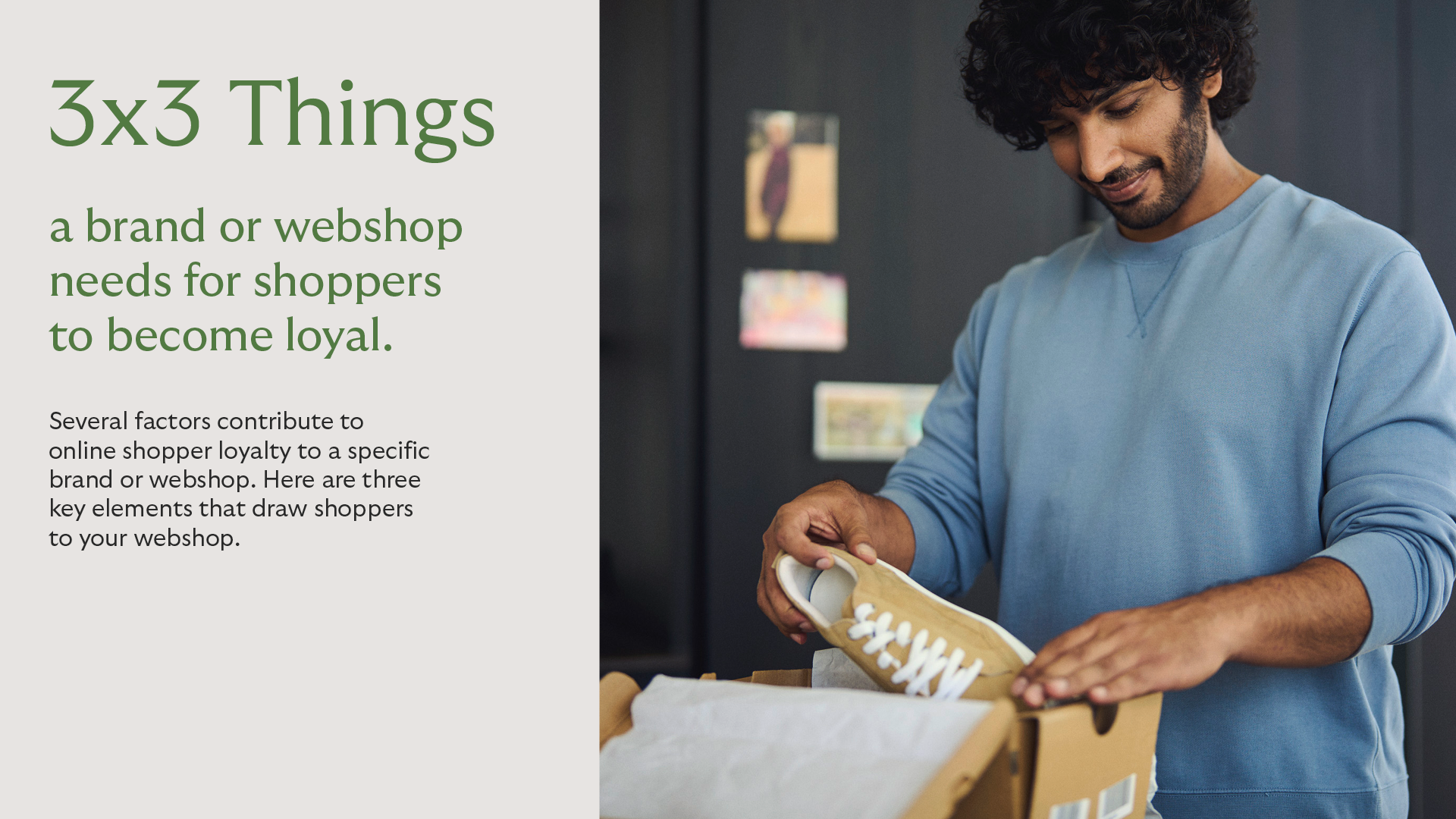
1. Exceptional Customer Experience
Providing a seamless and enjoyable shopping experience is crucial.
This includes a user-friendly website that is efficient, uncomplicated and inclusive to all users (total NL 77% + DE 84%), Fast (NL 50% + DE 47%) and secure transactions (NL 36% + DE 49%), and reliable customer support (NL 40% + DE 42%).
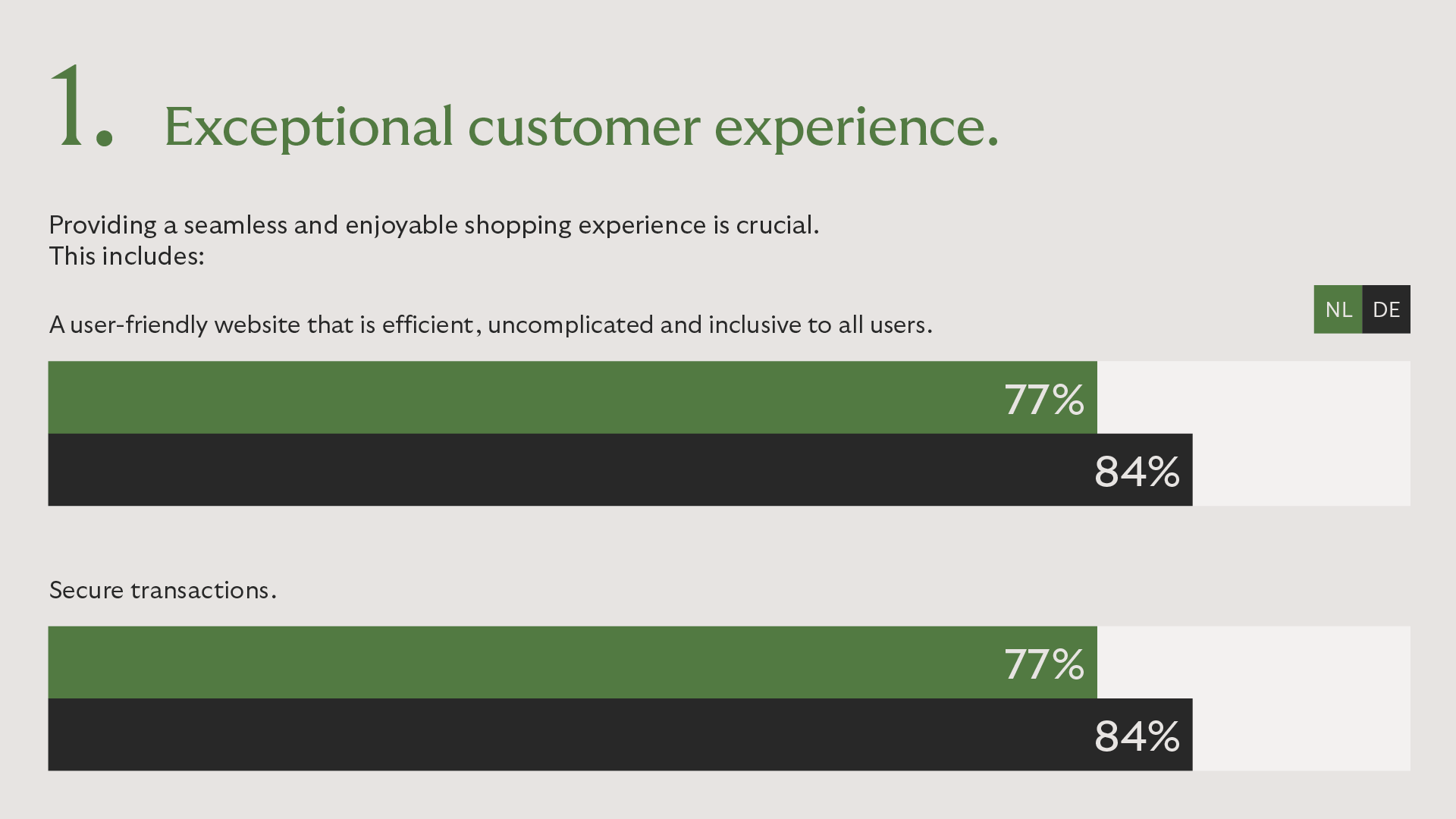
2. Product Quality and Variety
Offering high-quality products that meet or exceed customer expectations is vital for building loyalty (NL 24% + DE 27%).
Providing a wide range of products that cater to diverse customer needs and preferences also helps retain customers (NL 55% + DE 51%).
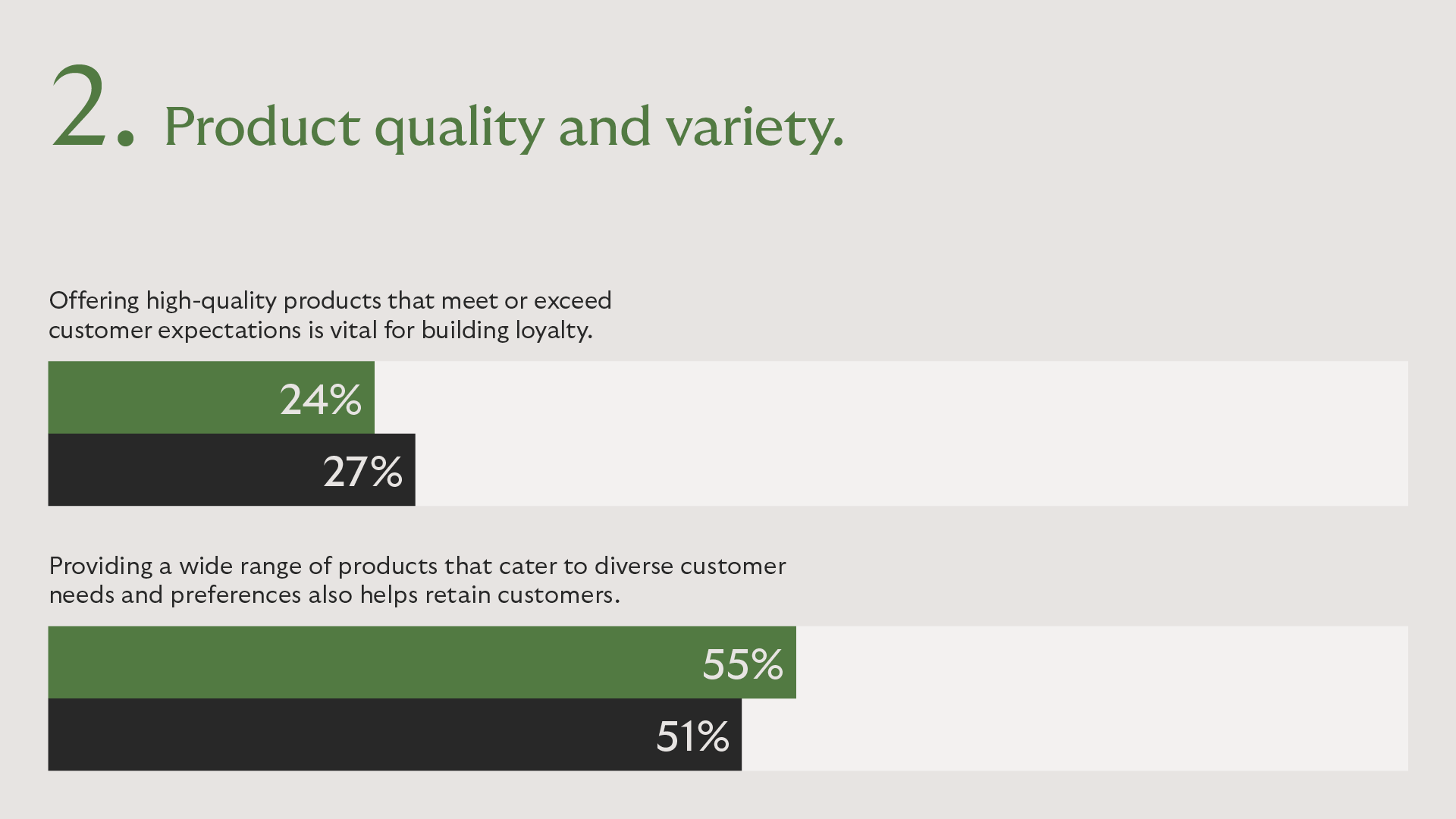
3. Competitive Pricing and Discounts
Pricing plays a significant role in shopper loyalty.
Competitive pricing, regular discounts codes (NL 42% + DE 36%), promotionaloffers, (NL 39% + DE 52%) and a payment method that is connected to a loyalty program where shoppers earn points and discounts encourage customers to choose a particular brand or webshop over others (total NL 21%, Heavy shopper 26% + DE total 19%, Heavy shopper 26%).
Noteworthy is the difference in lifestages and the use of discount codes: in the Netherlands the lifestages of Pre-family (47%), Post Family (46%) and Seniors (45%) use most discount codes in check out. However, the German shoppers in the Family stage (57%) are the biggest users of discount codes. Segment-specific: Rational & Efficient shoppers are the top users of discount codes (NL 71% + DE 57%).
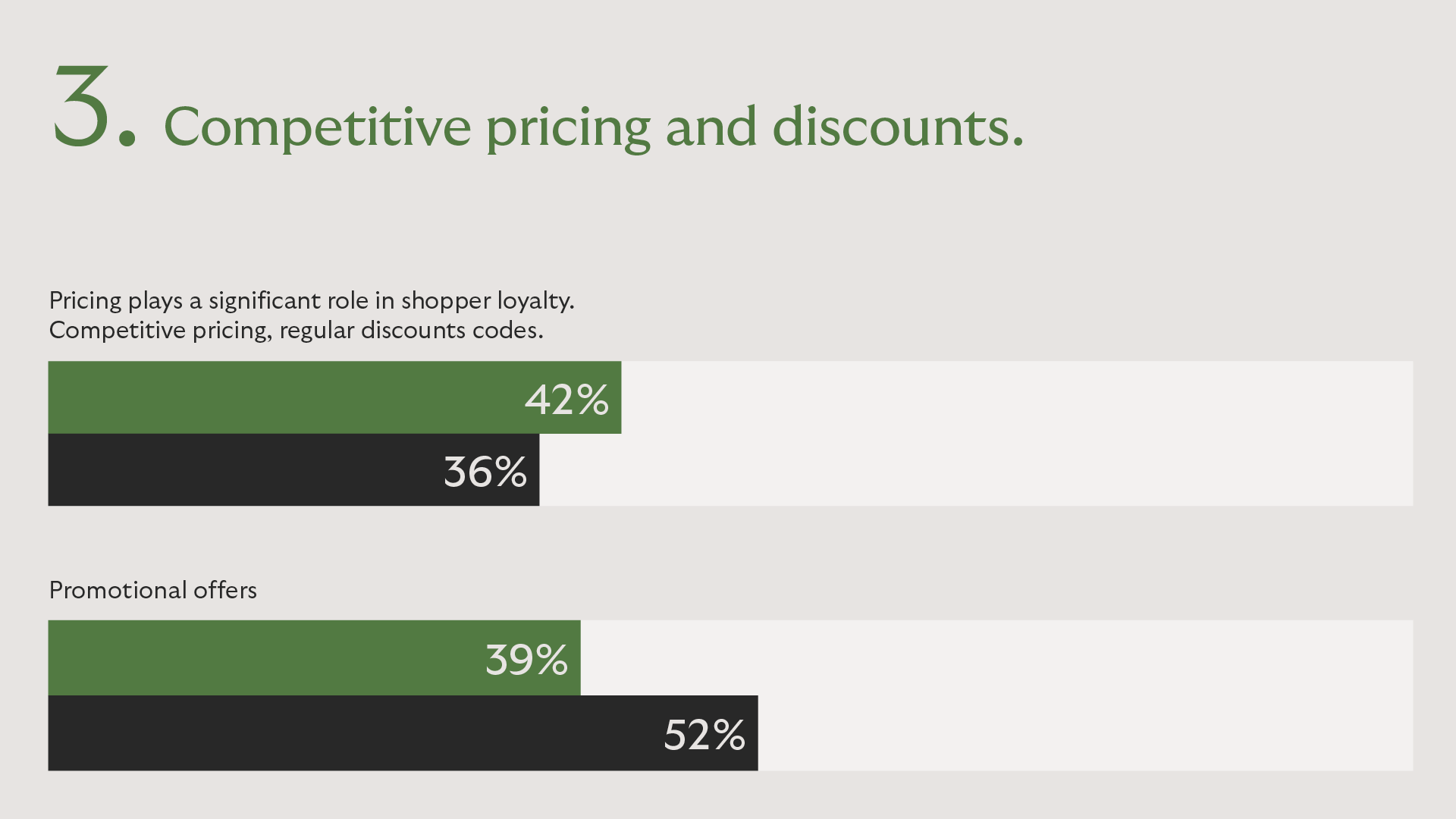
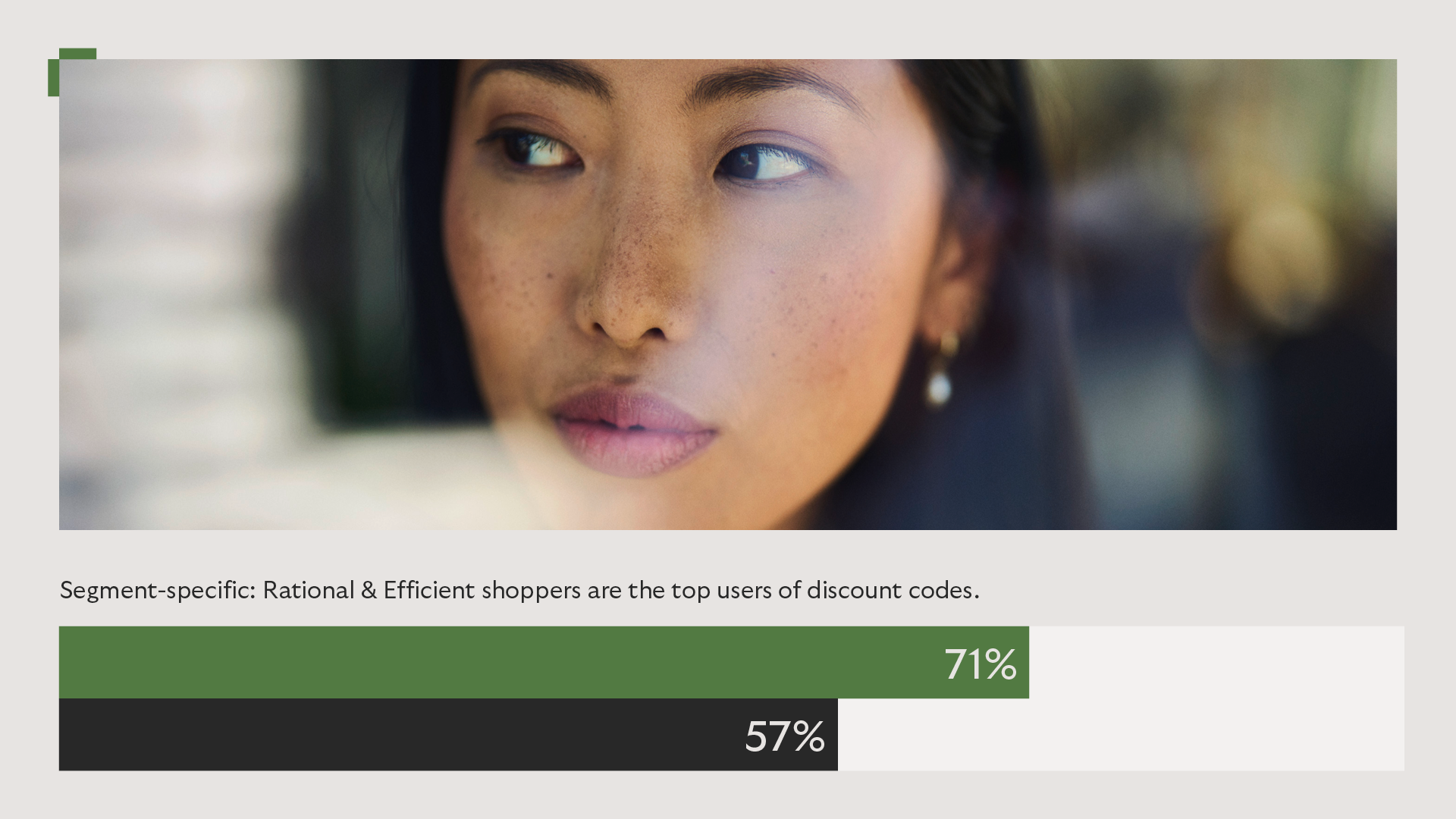
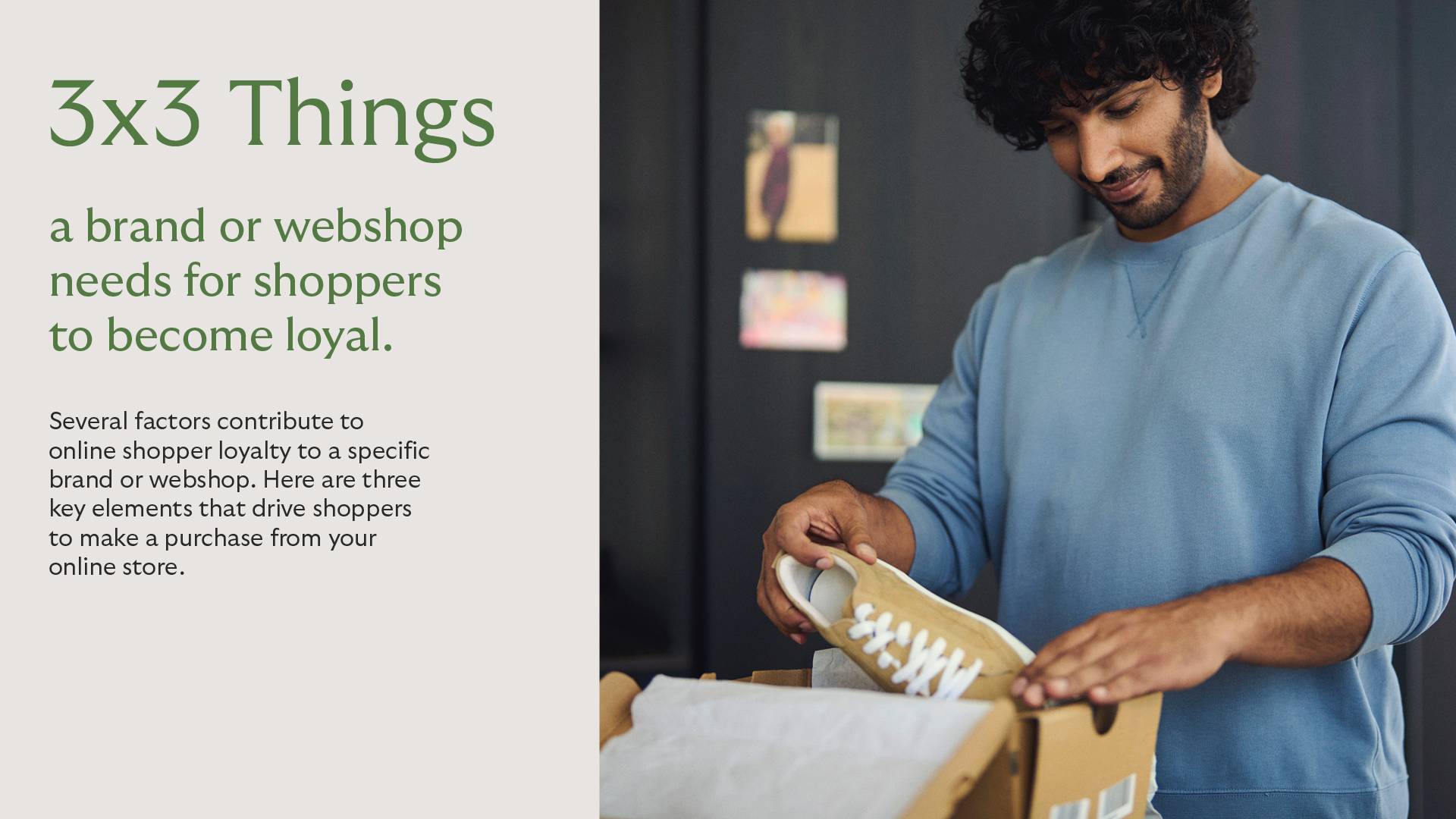
1. Be trustworthy and credible
Establishing trust is essential for online shoppers (NL 56% + DE 54%).
Brands that have a positive reputation and is well known (NL 58% + DE 55%**), cater to feelings of safety and security (NL 36% + DE 49%) via e.g. a seal of approval by a webshop trust guarantee service (NL 19% + DE 30%), and free and reliable delivery services (NL 84% + DE 88%) instill confidence in customers and encourage loyalty.
**Medium and Light shoppers have a much higher need (compared to Heavy shoppers) for using a well known payment brand (NL Medium 60%, Light 68%, Heavy 49% + DE Medium 53%, Light 59%, Heavy 46%).
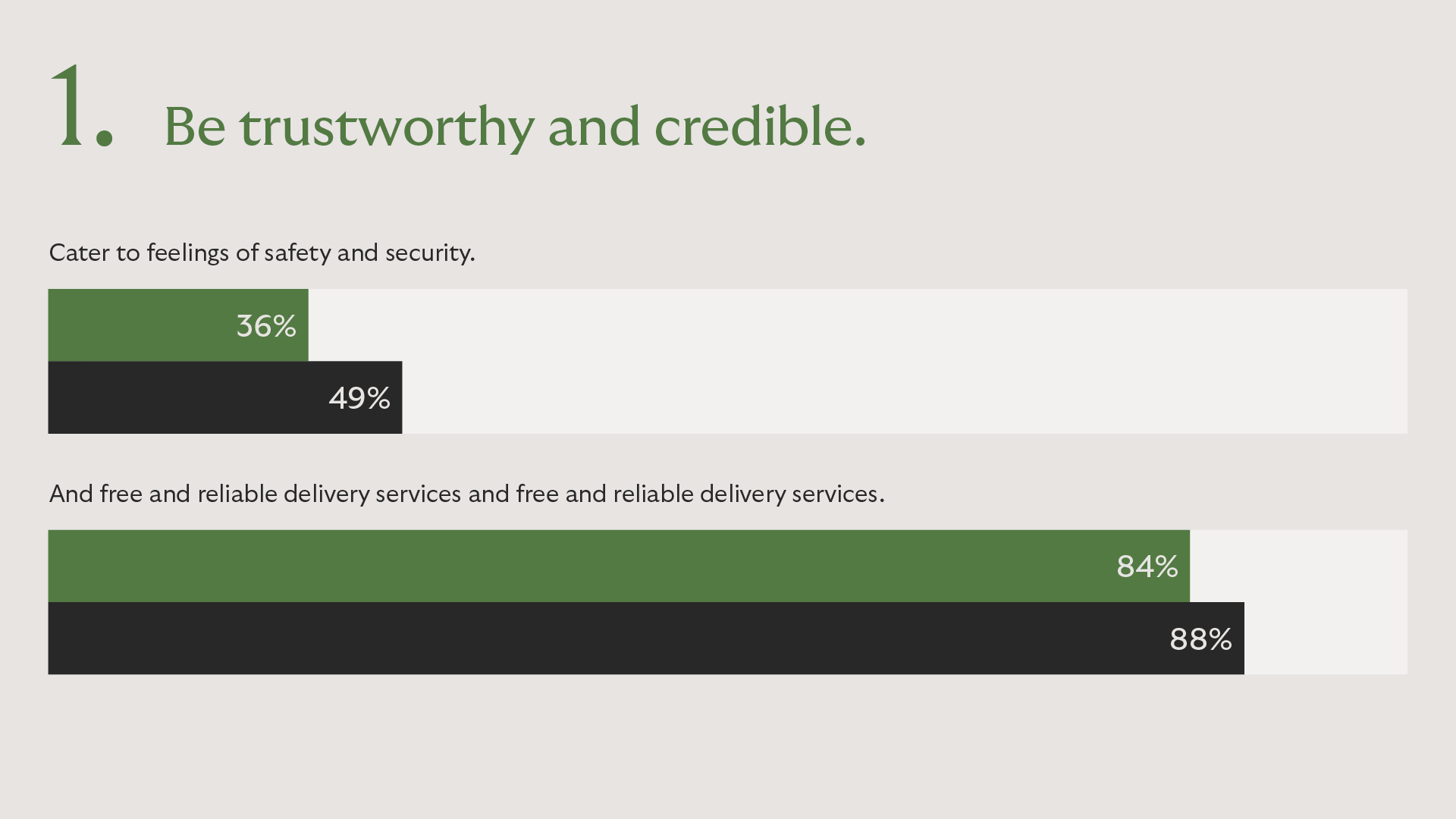
2. Social Proof and Reviews
Positive reviews, ratings, and testimonials from satisfied customers act as social proof (NL 31% + DE 35%) and can influence shopper loyalty. Encouraging customers to provide feedback and leveraging user-generated content can enhance brand credibility.
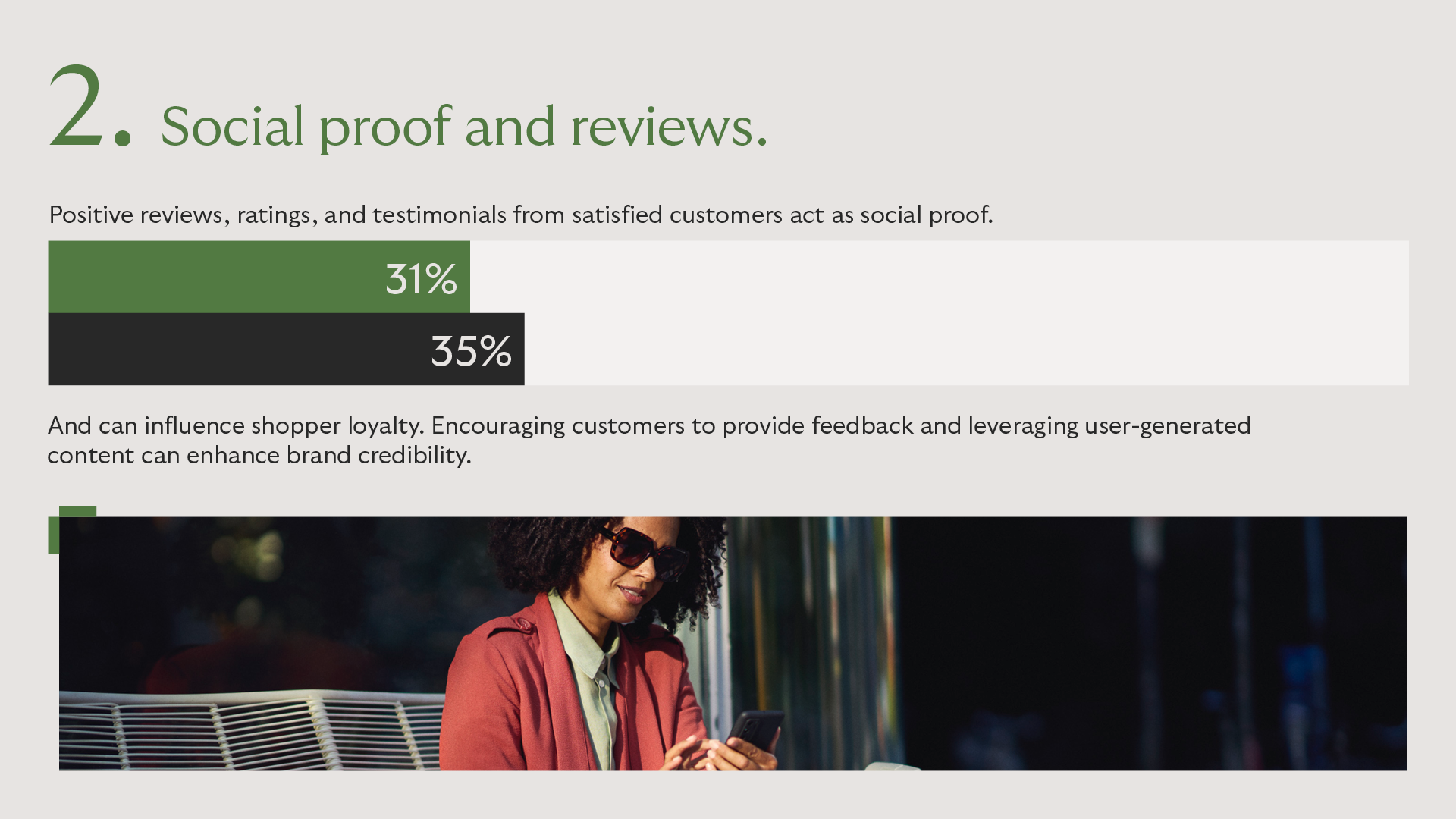
3. Exclusive Benefits and Rewards
Offering exclusive benefits, rewards, or early access to new products to loyal customers can foster a sense of appreciation and strengthen their loyalty. Shoppers want their selected payment provider to be connected to a loyalty program (NL 21% + DE 19%).
Heavy shoppers and shoppers who are in the pre-family life segment in particular see the benefit of a loyalty program and have a higher payment need for loyalty programs (NL Heavy shopper 27%, NL Pre-family 27% + DE Heavy shopper 31%, DE Pre-family 26%).
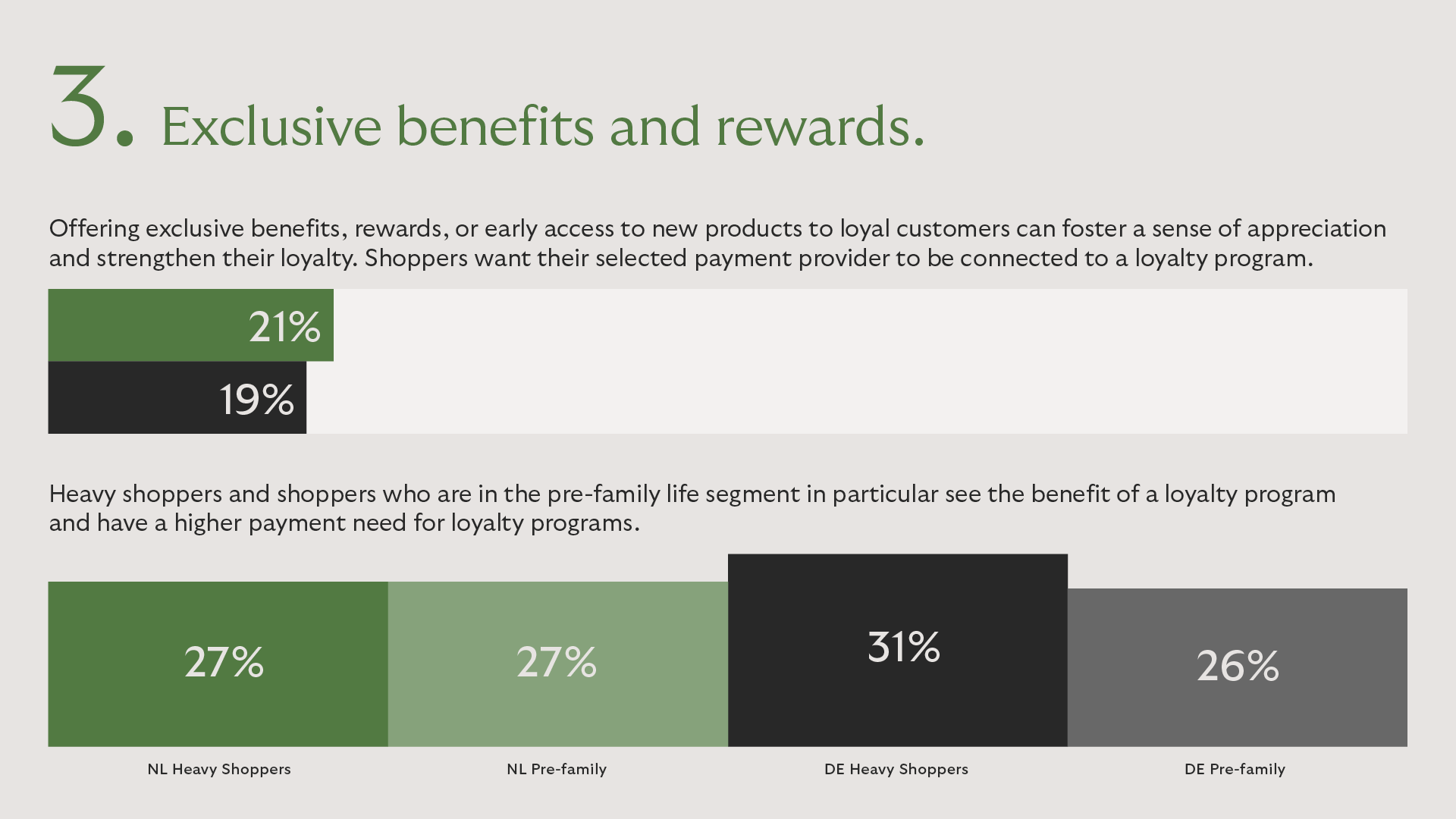
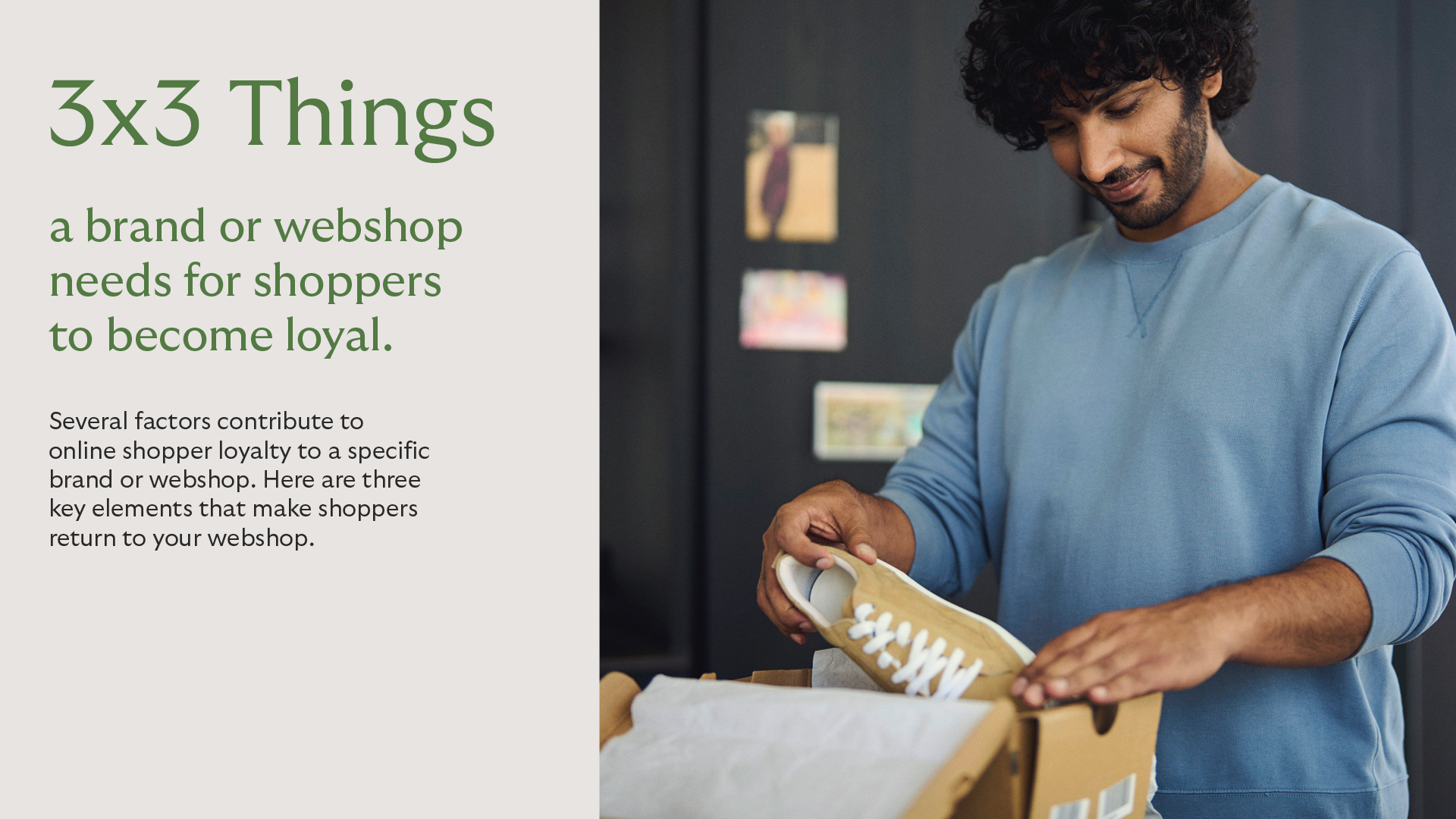
1. Add Personalization and Customization to your webshop
Shoppers love to be inspired and the element of surprise (NL total 26% + DE total 21%), and especially BNPL shoppers (NL BNPL shoppers 34% + DE BNPL shoppers 22%).
That bit of extra Fun (NL total 38% and NL BNPL shopper 40% + DE total 22 and DE BNPL shopper 31%) and thus tailoring the shopping experience to individual preferences through personalized recommendations, product suggestions, and targeted marketing efforts helps create a sense of connection and loyalty.
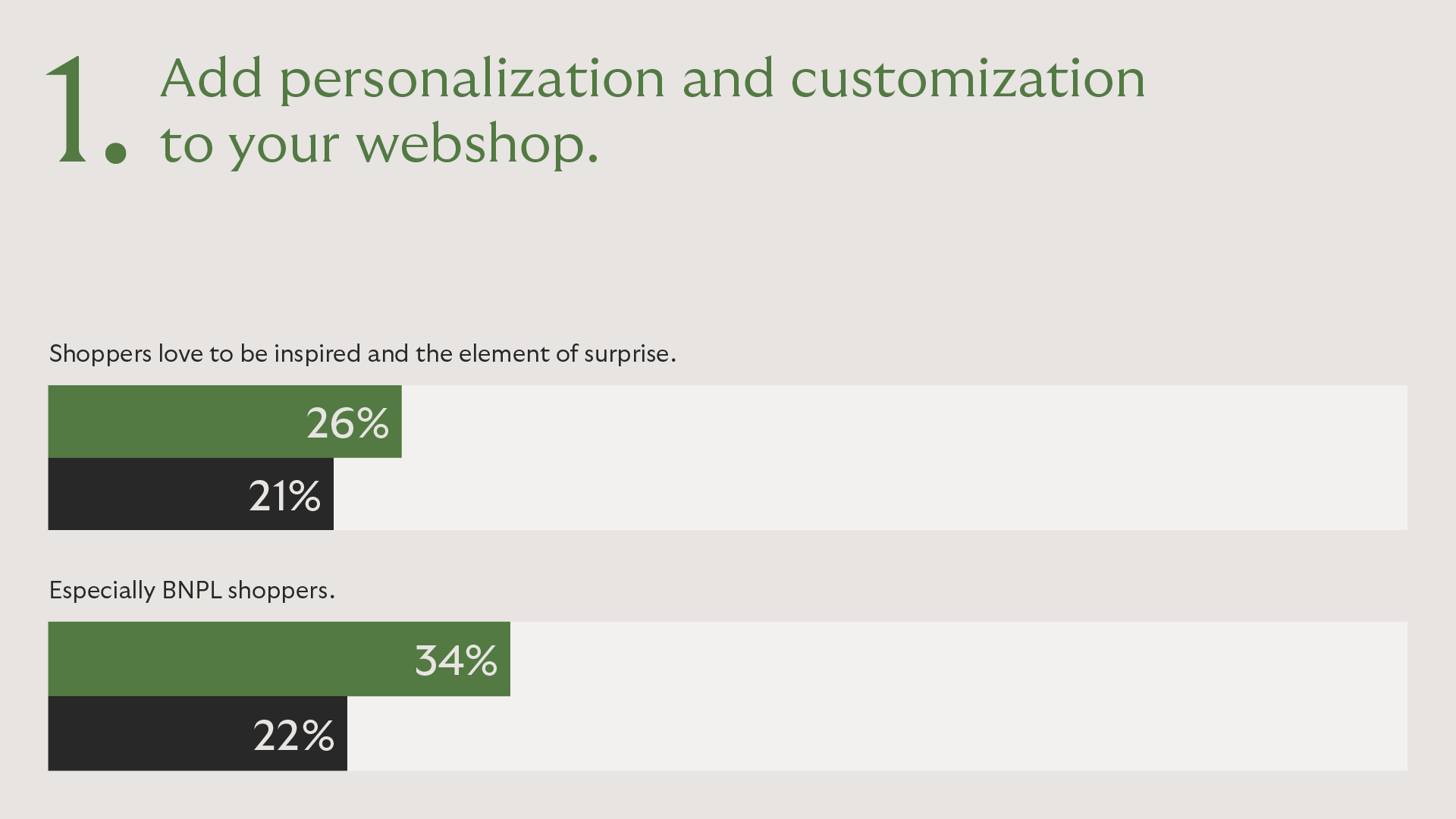
2. Brand Identity and Values
Brands that effectively communicate their values, mission, and story tend to attract and retain customers who resonate with those ideals. Shoppers often become loyal to brands that align with their personal beliefs and values.
Conscious shopping is becoming more important over time. The Dutch (36%) and German shoppers (34%) say to be most conscious online purchase-makers among the Europeans. Over a third now takes seeks for an experience, (local) business and/or products that holds mindful and intentional approach to making purchasing decisions, that are aligned with their personal values and beliefs. It involves being aware of the social, ethical, and environmental impact of the products and brands we choose to support.
The goal of conscious shopping is to make informed choices that have a positive impact on both individuals and the planet. It is fair to say that there are some differences in the level of consciousness in both markets. The older generation of shoppers (NL age 65+ 49% + DE age 65+ 43%) is more Conscious than the younger shoppers. In short, the older the buyer, the higher the need for a conscious buying decision.
Of course the segmented shoppers contains disparity: Conscious & sustainable shoppers care most about Consciousness (NL 68% + DE 67%). However, the Exclusive & Premium segmented shoppers say they seek alignement too in Consciousness (NL 41% + DE 34%). Noteworthy: 37% of the German Bargain shoppers say they seek for a Conscious value driven brand or product, too. The Dutch Bargain shoppers level at 36%.
As much ground is already won for being conscious, the prioritization of Purposful Consumption is lagging behind in the statistics, for whole of Dutch and German shoppers (NL 8% + DE 14%). The segmented Conscious & sustainable shoppers (NL 11% + DE 17%), Shopping Lovers (NL 11% + DE 13%) and the Exclusive & Premium shoppers (NL 10% + DE 13%).
Lastly, Purposful Consumption is present in the shoppers who have been subjected to debt collection some time in the last six months (NL Debt collection subjected shopper 20% + DE Debt collection subject shopper 14%), while the overall Dutch and German share of Purposful Consumption is low (NL 8% + DE 14%).

3. A Seamless Omnichannel Experience
Providing a consistent and integrated experience across various channels, such as website, mobile app, social media, and physical stores, helps create a cohesive brand experience and increases shopper loyalty.
Mobile applications not only make the shopping user-experience on a smartphone better, it also takes advantage of mobile features like touch gestures and push notifications (e.i. stock alerts, discount codes or payment reminders). An app on a shopper’s phone creates a bigger presence in their life and add to feeling connected and/or feel loyal to a brand. Shops and brands who also have an app is especially favoured by the heavier shoppers who also tend to use a BNPL-payment product (NL total 15%, NL BNPL-user 18%, NL Heavy shopper 18% + DE total 17%, DE BNPL-user 17%, DE Heavy shopper 21%).
Cross-channel availability of a brand or product makes the online shopping experience better. The wide availability taps into convenience and speed of online shopping. The shoppers in the Netherlands have a higher preference of cross-channel availability than the German shoppers. The biggest difference is visible among the Dutch Bargain Shoppers, where a 3 in 5 shoppers who hunt for great and quick deals want their preferred brand to sit across channels (NL total 22%, NL Heavy shopper 18%, NL Bargain shoppers 61% + DE total 16%, DE Heavy shopper 21%, DE Bargain shoppers 12%).
Physical stores will always play a role in the lives of shoppers. For some a bigger role, for others a small role. It inspires the buying audience, provides a hands-on and sensory experience, social interaction, adds to trust, helps with doing product research, and ,while online shopping offers convenience, returning or exchanging items can sometimes be a hassle. Physical stores provide the advantage of easy returns and exchanges and play a more sustainable role in returning items (instead of the post). The integration of both physical and online channels can provide a holistic shopping experience and cater to the diverse preferences of customers.
Shoppers of the Netherlands a slightly bigger need for physical stores compared to their German neighbour shoppers (NL total 12% + DE total 7%). Both countries see the Smart & Innovative shopper segment to have the highest desire to also be able to visit a physical store (NL Smart & Innovative shoppers 16% + DE Smart & Innovative shoppers 12% - while all other shopper segments are below 10%). The Smart & Innovative shopper may prefer physically examining products before making a purchase. They possibly want to assess the quality, size, or suitability of an item, or compare different options side by side. Physical stores allow for this hands-on evaluation, which can be crucial for certain products, such as clothing, furniture, or cosmetics.
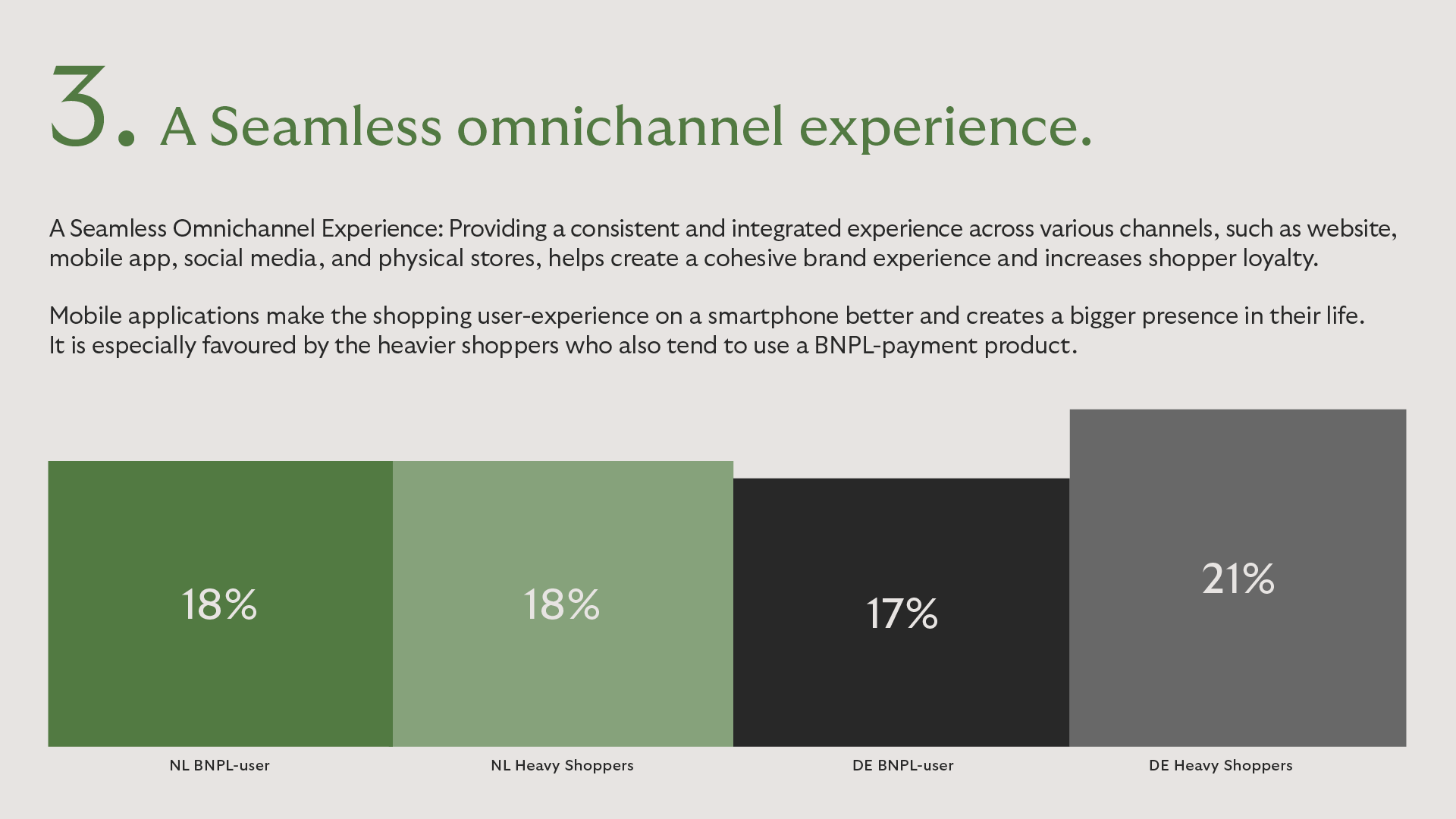
In sum:
It's important to note that these factors can vary depending on the specific preferences and expectations of different customer segments. Therefore, understanding and catering to the unique needs of the target audience is essential in building shopper loyalty.
It's important to note that loyalty can vary among individuals, and factors such as pricing, product range, customer service, and overall shopping experience can influence customers' loyalty to a particular webshop. Additionally, shopping preferences can evolve over time as new players enter the market or existing platforms adapt and improve their services.
Looping back to the big retailers in Germany and The Netherlands: actions to gain lotalty and customer satisfaction.
As mentioned earlier, Dutch consumers tend to exhibit a certain level of loyalty to online retailers such as Picnic, Bol.com, Zalando, Just Eat (Thuisbezorgd), and Amazon.nl, whereas the German e-commerce platforms in Germany include Zooplus, Booking.com, Amazon.de, Zalando, Otto, Just Eat (Lieferando), and eBay.de.
These companies have established a strong presence in the Dutch e-commerce market and have gained a reputation for providing good customer service and a wide range of products. These major brands and retailers understand what the consumer wants and needs and try to cater this to their audience, as best as they possibly can, and also stay on the lookout for and adapt to changing needs and behaviors.
The abovementioned stores tick (almost) every box of our tips in this article:
Exceptional Customer Experience, Product Quality and Variety, Competitive Pricing and Discounts, is credible and trusted, has personalized elements to suprise their shoppers, has a place to leave and read reviews from others, offers exclusive Benefits and Rewards, create a Seamless Omnichannel Experience, communicates their brand identities and values, and, some have physical stores.
The impact of loyalty
Loyalty can have a significant impact on a webshop. Here are a four key ways loyalty can benefit a webshop:
- Repeat Purchases: indicating customer satisfaction and builds relationship with a brand or product.
- Higher return of Customers in your webshop/use of brand or product
- Positive Word-of-Mouth: we all enjoy taking the stage and share a story about that brand we love.
- Reduced Marketing Costs: Acquiring new customers can be costly, but loyal customers require less marketing effort and expense.



